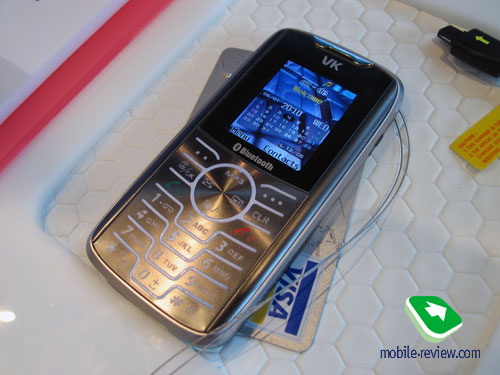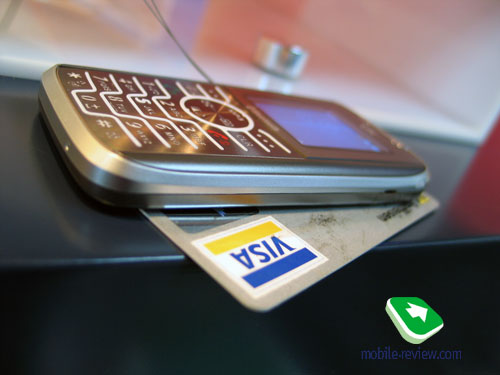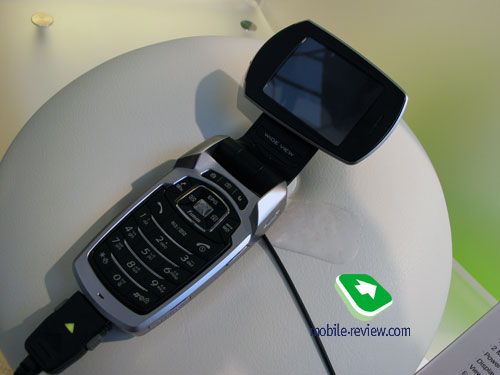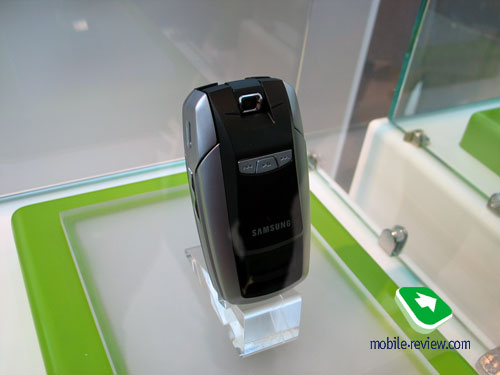CeBIT has been the center of attention for those who wanted to
see how computer and telecommunication technologies will develop
within the next year. Companies from all over the globe came to
Hanover in order not only to show their products that will be
released in the nearest months, but also prototypes, that are
targeted for far perspective. When we had slow network development
and the world was more conservative, there was a reason for such
events. It was sort of a private club, where professionals were
able to talk to each other, see not only what was shown in the
booths, but get access to “secret” rooms as well. From the moment
when Internet entered most houses in Europe, the spread speed
of information became almost momentum. See it four yourself, information
from product’s presentation appears on the internet with only
couple of hours delay, and articles that include product’s analysis
and sometimes even full review of it – within couple of days.
This was an unreal time term for 1980s. The information is distributed
in a different way, and rather often you should not be at the
place to feel and see what the event is all about (unfortunately
for now you cannot “touch” things). This changed consumer’s POV,
who began to read closely about the products he is choosing from,
he reads the gossips about future products and possible changes
in price policy changes of companies. This is a big headache for
marketologists of all companies. On the other hand, communication
with consumer is happening on a different level, this partly solves
the case for PR-agencies, the main goal now is to create an interesting
product.
The role of world exhibitions is going downwards when the conditions
are as they are now, and this was successfully proven by this
year’s CeBIT. On the whole CeBIT became a regional exhibition
targeted only at German citizens, people from Hanover and cities
nearby to be precise. Every year we’ve seen that a lot of manufacturers
were ignoring CeBIT and holding off their announcements for some
better day. At first it were computer companies, later on telecommunication
sector joined the rally. Dangerous tendency wasn’t that obvious
due to overwhelming activity of Asian manufacturers, they were
compensating their late arrival at European market with great
amount of announcements. This year the exhibition hit the critical
point, it just became uninteresting. If we talk about mobile phones,
the only company that held the Ace in its pocket, and was ready
to announce new products was BenQ-Mobile. Well, that’s quite logical,
since German market is what Siemens had left as legacy, it is
its home, this is where the company has the strongest position.
However, it will be just to say that all products announced at
CeBIT were already discussed before the official presentation,
every reason for holding up the interest is important to hold
the slippery of sales. This includes “accidental” leaks. Samsung
announced couple of products, including its flagship, not because
of the particular event, but because of its own uncertainty. The
company could not decide which product should become the flagship
for whole 4 months, and this caused active correspondence within
the company itself. Main wave of announcements hit 3GSM Congress,
and the reason for that is because this event is particularly
specialized in mobile telecommunications. The exhibition was slowly
but steadily taking away professional auditory from CeBIT, since
it was held earlier, and this very professional auditory was its
main target. You could not see a big amount of young people wandering
around the Congress. Development of online media that are covering
the exhibition is not influencing the fact that companies and
their representatives gather at this event and speak about the
products and technologies. For mobile phone market it’s 3GSM Congress
what’s considered as central event of the year, and this has been
so for 3 years already. Basically, you can say “rest in peace”
to CeBIT starting from next year in case you are interested in
mobile phone, none of the serious manufacturers is planning to
attend this exhibition, or make any serious announcements. Most
journalists were complaining that what has been shown on the exhibition,
could have been spotted on the internet, or some other way before,
the products are not so interesting because they are already known
about. The overall mood was like one single point: going to CeBIT
next year does not look reasonable. I shall say goodbye to CeBIT
at this point and move on to interesting tendencies spotted on
recent exhibitions.
NOTMOTORAZR
Very likely there hasn’t been any other mobile phone besides
Motorola V3 RAZR that had big impact on the market. One month
before the official announcement of V3 RAZR (it was in summer
2004) we placed an unpretentious message on our forum which was
something like this: “after 26 days the idea of clamshell phone
will be reloaded”. After the review and official announcement
it was interesting to follow reaction of our readers. Almost everyone
agreed that this model was original and interesting, however most
agreed that it wasn’t something revolutionary, it did not change
the way we think about clamshell phones, our associations. Motorola’s
competitors had their own vision on this matter. The consumers
proven that this vision was true, after they spent their euros
on brand new RAZR, pushing it to best selling mobile phone in
Europe position (data provided by Motorola at 3GSM 2006). Saying
that Motorola V3 was a successful product means saying nothing
at all.
It took time before competitors were ready to demonstrate their
counter-attack. We should not forget that it takes quite a while
to develop mobile terminal. The first question was who will be
the next to show its vision of “slim” phone, now it’s time for
the final one “who will be the last one?”. Just year before at
3GSM Congress 2005 and CeBIT 2005 we seen only the beginning (as
it turned out later) of giant wave of RAZR clones. This year’s
CeBIT caused critical point of RAZR-mania, manufacturers were
clashing for every 1/10 of millimeters in thickness.
You should not that it was not always only about replicating
Motorola’s product with maximal accuracy. A lot of models were
similar to Motorola’s hit only in terms of thickness, however
there were those who were copying everything without any feeling
of vain (except for crossing the line, which would cause immediate
notice of appointment). Motorola was forced to make a strong decision:
from now on models will be announced simultaneously with their
release on the market (similar to what Apple is doing with iPod),
so the competitors would not have enough time to copy the design
of new products.




At CeBIT 2006 we seen “the thinnest phones in the world”, the
clash between manufacturers was really huge, like we said earlier,
even 1/10 of millimeter was at stake. VK Mobile came out victorious
with its models VK2000/VK202, since their thickness was 8.8 mm,
which is by 0.1mm thinner than Samsung Z150. Although Z150 remains
the thinnest… UMTS terminal. In the nearest future Samsung will
release its version of SLVR, with 6.9mm thickness, the war is
not over yet. LG was slightly behind the “leaders” with its model
LG KG320, the thickness was 9mm. Right after the exhibition closed
its doors, KTFT announced even thinner model for Korean market,
EV-K100, its thickness is only 7.9 mm.




VK Mobile can be highlighted as the company that made most efforts
in replicating RAZR. All of its new models were slim, and similar
to Motorola’s analogues in this or that way. VK200 is a slightly
scaled down (dimensions – 105x48x11 mm, 66grams) clone of Motorola
L7. Models are so similar to each other, that at first visitors
were rather dazzled, it seemed that VK Mobile put Motorola’s model
for comparison. VK 4000 – is an external copy of Samsung D500,
meanwhile VK 4500 tends to look more like a RAZR in terms of keyboard
design and case’s thickness.
Coverage from VK Mobile
booth >>>

Samsung presented “the slimmest slider”, D870. It will be just
to say that the only similarity with RAZR in this case is small
thickness.
Coverage
from Samsung booth >>>




Sharp has finally shown its vision of RAZR, by announcing model
770SH. Because of straight line domination and small monochromic
external display when the phone is closed it reminds more of “slim”
phones from Panasonic, instead of RAZR, but once you open the
phone, you will see the metal plate with keyboard, which sets
everything back at its place. The model is not the thinnest, that’s
for sure, its dimensions are 101x49.9x17.1, weight is 110 grams.
It is interesting because of UMTS, GPRS (EDGE is not supported)
support, there’s Bluetooth and slot for microSD memory cards,
qualitative 2.2” QVGA-display (it is made by Mobile Advanced Super-V
LCD technology, which is actively promoted by Sharp).


Candybar TS608 from Toshiba (TS30 – Asian edition of this model)
joins the “slim solution” rally. Model’s dimensions – 110.5x46.9x9.9
mm, weight - 93 grams. Among other functions there’s Bluetooth,
mp3 player, slot for microSD memory cards, 1.3mpx camera. The
mode is expected to go for sale in May.
Nec decided to show its model called e959, unlike previous slim
model (e949), the keyboard is now more similar to RAZR’s.

Chinese company TCL had another clone of Motorola L7 SLVR in
its booth. The model is targeted for Chinese market, and there’s
nothing else that we were able to find out about it.

Let us remind you that slim models were presented by Sagem as
well, we wrote about it in our coverage from the exhibition.
Coverage from
Sagem booth>>>


Another slim slider was featured by Grundig – on top of it, X300
has a 3 Mpix auto-focus camera module embedded.
It’s interesting, that now all manufacturers have managed to
make public their “slim solutions” – of the leading players on
the market, such models are not presented in Sony Ericsson’s and
Nokia’s line-ups. Models Sony Ericsson M600, W950 and Nokia 8800
can be nominally referred to slim ones, although they were announced
as neither thin handsets, nor targeted at the mass market in the
first place, what is more these don’t bear much of similarities
to RAZR. Not so long ago Nokia has undergone major shake-ups in
the design department – it got it structure and head manager changed.
It’s for sure, that Nokia is currently developing a product line
of “slim and stylish” handsets – so the question is, when these
models are going to be released. In other words, who is going
to be the last in this race?
With the advent of V3 RAZR, not only a standard clamshell’s appearance
was revised, but outlook of all handsets, residing in other form-factor
categories as well. It won’t be long before thick devices become
a thing of the past – as of today, the evident infatuation for
“slim” handsets reminds of the competition among the manufacturers
in reducing measurements of phones from clumsy “bricks” to what
we can see at present. The experience, earned in those times implies
that downsizing has certain limits, which not a single handset
would exceed, since using too small device causes way more problems.
The manufacturers realized that simple truth back then and eventually
will come to this conclusion one more time, after they understand
that a phone of 5 mm thickness is unclaimed on the mass market.
Mobile television
One of the CeBIT 2006 hot topics is, no doubt, mobile television.
Many companies took the chance to demonstrate devices of their
own products at the exhibition. To tell the truth, mobile operators
pin all their hopes on this technology, as according to them it’s
going to become a major source of income.
Rivalry between various incompatible standards is frequently
one of the insuperable obstacles on the path of developing a new
solution. One of the most obvious examples one can see in the
modern world is confrontation between two standards: Blue-Ray
and HD-DVD. At first many prospective buyers are delaying the
purchase in order to wait a bit and see how it turns out. But
the full-scaled competition of several technologies is currently
observed on the market of mobile TV.
There are far more ways of delivering a vivid picture, streamed
in real time mode, to small screens of mobile phones that you
can imagine. Let’s take closer loot at all this variety. Obviously,
the simplest way to make a handset work as a television set is
to integrate an analog television receiver into a phone. And naturally,
this approach is applied by several companies with such names
as Sharp and currently being a minor player on this market, GIGABYTE.
On the other hand it’s widely known that analog transmissions
are not intended for using on portable devices, so an external
antenna becomes a very vital detail, nonetheless no one will guarantee
fair reception quality even in this case. Power consumption –
that’s what everything is about. Stated battery life of Sharp
905SH in TV mode is from 0,5 to 1 hour. In other words it is enough
to cover only the first half if we want to watch a football match,
for example. Profit, gained by mobile operators in this case is
rather obscure, as the operator doesn’t provide content here.
The other method is applying IP (IPTV) technology – it can be
GPRG, UMTS, HSDPA or mobile MiMAX, there is not core difference
which one to use. It’s an easy way as well, which doesn’t require
any additional expenses on infrastructure creation, though frequencies
are not properly distributed in case, what involves extra traffic
and network overload. If a network like this includes only a dozen
of users, any further questions issues are excluded at once, however
when 10-15 thousands of people will tear into the network, willing
to watch the opening ceremony of the Olympic games, or, say Football
World Cup matches? In these cases nobody can provide stable operation
of any system – just remember what happens with GPRS during peak
hours. Though the market features numerous IPTV solutions, opened
both for any company and exclusively developed for several operators.
One more way to materialize the concept is modification based
off the existing 3G-infrastructure, which would use dormant part
of the capacity. We are talking here about Multimedia Broadcast
and Multicast Service (MBMS), which is included in the current
set of 3G standards and allows its users to considerably reduce
incoming traffic. At this licensing of additional frequencies
is required. Orange mobile operator is going to apply TDtv by
IPWireless in the middle of this year as a trial attempt of using
this service.
Space television is also possible on mobile phones even without
using an external receiver. In South Korea this method has already
been in exploitation for quite a while, originally launched as
S-DMB (Satellite Digital Multimedia Broadcasting) service. Nevertheless
even the Korean ever-growing market could give only 1.5% of infiltration
– it’s doubtful that this technology will become a hit outside
this country.
And finally, the last but not the least – the way of ground-based
digital broadcasting, which can be carried out only with the help
of extra licensed frequencies. This field is occupied with the
following contending standards: T-DMB (Terrestrial Digital Multimedia
Broadcasting) – available in South Korea, though commercial launch
in Germany is scheduled for the period right before World Cup
start. MediaFLO – Qualcomm’s technology, covering the widest audience
in the US. DVB-H – the most promising standard in Europe, supported
by the majority of manufacturers.
Having looked into various technologies, we are getting straight
down to the corresponding handsets’ manufacturers. And we are
beginning with Samsung and LG – it may sound hilarious, though
these two claiming the title of “the only company world-over,
supporting all types of mobile television without exception”.
I should admit that is partly true, as the manufacturers provide
handsets for all invented standards.


Model Samsung SCH-360 is primarily targeted at the Korean market
– in fact it is nothing else but Samsung D600 with a built-in
S-DMB receiver. There is also a video-out for better experience
of watching TV broadcasts.

Another model with an embedded S-DMB receiver is SCH-B340 – pretending
to being “the slimmest handset in the world with S-DMB”, its thickness
measures 17.3 mm.


The first device world-over, supporting both S-DMB and T-DMB
at once is SPH-B4100 – the same design is applied to a handset,
featuring MediaFLO, yet there is no word on its index.


One more “first world-over” device is a gamephone with incorporated
S-DMB, namely SPH-B3200.


DVB-H is put in model Samsung P910.



IPTV isn’t left out either – via the company’s very own AnyFilms.net
one can watch short-length on-line movies. Only time will tell
how this idea will turn out.

The main point of attraction at LG booth was seized by mobile
TV – in the center of the stand we discovered an enlarged copy
of LG FLO Phone – a handset supporting MediaFLO. Actually all
other models differed only in types of video receivers.

S-DMB is announced in model SB130.

A cell-phone featuring DVB-H, no additional data available.

And this model has T-DMB standard embedded.

In its turn, Sagem demonstrated a pre-production model of MyMobile
TV with a built-in DVB-H receiving set.



At Nec’s booth we also found a device with a DVB-H-receiver.
Considering the fact Nokia has already made public that its newest
N92 supports DVB-H, and on the other hand Motorola and Sony Ericsson
have announced support of this standard, it becomes absolutely
evident what standard Europe is doomed to. Nonetheless mobile
television is only in its first stages – staring from the middle
to this year a lot of manufacturers will strive for attracting
wide audience and as of today, it’s not clear whether the service
will be as successful as it is predicted to be by its followers.





































